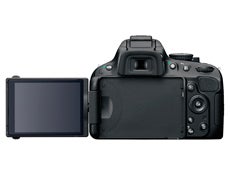How well does the Nikon D5100 walk the line between beginner and mid-level enthusiasts? The What Digital Camera Nikon D5100 review finds out…
Nikon D5100 Review
Nikon D5100 review – Features
 The Nikon D5100 has a number of modes and features that Nikon is keen to shout about: First of all it’s got an LCD screen mounted on a bracket for 360 degree
The Nikon D5100 has a number of modes and features that Nikon is keen to shout about: First of all it’s got an LCD screen mounted on a bracket for 360 degree
positioning at more unusual angles – an ideal accomplice for videographers looking to use the 1080p Full HD movie mode to best effect.
Secondly is the new Effects mode that opens up seven specific options for immediate in-camera results: Night Vision; Color Sketch; Miniature; Selective Color; Silhouette; High Key and Low Key.
Their appeal is leaned more towards the mass market, where companies such as Olympus have seen some success, though the balance of such ‘fun’ options inside a rather well-specified piece of kit may cause some more serious photographers to question the camera’s main focus.
See all full-size sample images of the Nikon D5100
Fear not, then, that the Nikon D5100 is rather like a head-on collision between the current D7000 and D3100 models. The same 16.2MP APS-C CMOS sensor as found in the D7000 makes its way into the D5100 body alongside the EXPEED 2 image processing engine for top-flight image quality. Metering is taken care of by the same 420-pixel RGB sensor as found in the D3100, where the same 11-point AF system and Li-ion battery are also imported to the D5100’s spec.
But it’s far from copy and paste: The Nikon D5100’s left-side mounted vari-angle LCD screen is certainly a new approach from Nikon, while other features such as live view get a makeover for faster focusing than any other Nikon DSLR. The 1080p movie mode also sees the inclusion of 30/25/24fps adjustable frame rates.
Nikon D5100 review – Movie/Video Mode
With the updated and faster live view update in mind, the Nikon D5100’s 1080p HD movie mode takes an immediate benefit. Focusing is improved, that’s fair to say, though the common over- and under-focusing inherent in many DSLRs’ capture hasn’t been eradicated in full.
While many DSLRs offer fixed focus (i.e. no autofocus at all) or a basic AF-S (single autofocus) option, the D5100 does bolster its movie arsenal with the inclusion of an AF-F (Full Time Servo) focusing option.
This is close to a continuous autofocus mode in some respects and is useful for some situations – but it can’t overcome slight mis-focusing when the camera moves from different focal planes or even from subject to subject.
Where the camera is held very steadily and moved between two stationary and prominent subjects the results can be very good indeed by smoothly and accurately sliding between focus points. The only way there could be a marked improvement in autofocus is for the contrast-detect focus type to see significant work – something Compact System Camera manufacturers are finding an essential to offer a fast, relevant competitive product.
The movie mode is reasonably comprehensive for a camera at this level thanks to the inclusion of a 3.5mm mic jack for external recording and selectable 30/25/24fps capture options – all of which are progressive capture, not the inferior interlaced form.
However there’s no full manual control within the movie mode, as the camera automatically overrides any live shutter or aperture adjustment in the Manual setting. In other priority modes it is possible to use the AE-L (for focus and/or exposure lock) and exposure compensation buttons that both help to enhance control to some degree. It’s even possible to utilise the Effects modes during recording, though the sheer reduction in the preview frame rate on the LCD screen can be rather painful to use to great effect.





